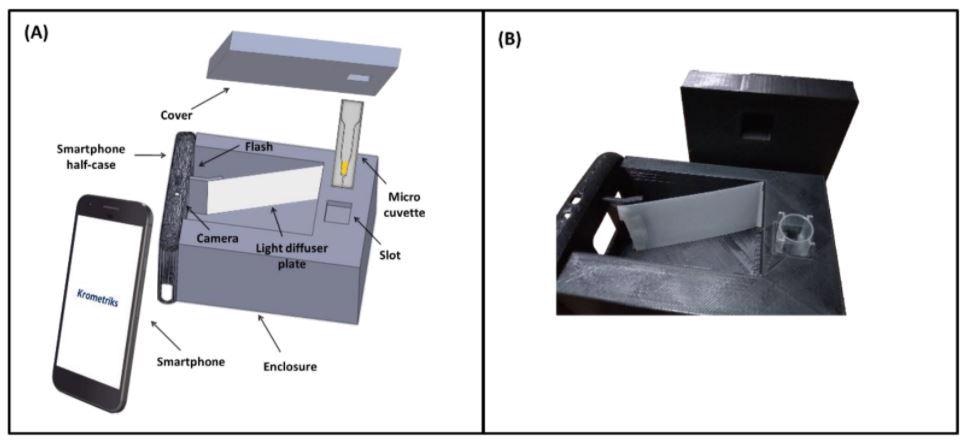In a recent study published in the journal Sensors, the development of a smartphone-based device called Krometriks is discussed, which utilizes nanotechnology to enable easy and quick colorimetric identification of microRNA (miRNAs).

Study: Smartphone-Based Device for Colorimetric Detection of MicroRNA Biomarkers Using Nanoparticle-Based Assay. Image Credit: Likoper/Shutterstock.com
The gadget comprises a smartphone, a 3D printed attachment, and a specially designed bespoke mobile app.
The Detection of MicroRNAs
MicroRNAs (miRNAs) are small RNA molecules roughly 25 nucleotides long and play a critical role in gene regulation by attaching to untranslated sequences in messenger RNA (mRNA). Doing so enables these non-coding RNA molecules to operate as regulators for post-transcriptional gene expression.
Dysregulation of miRNAs is common in cancer, cardiac diseases, diabetes, neurodegenerative disorders, and autoimmune conditions.
MicroRNAs, therefore, have the promise to be helpful indicators for early diagnosis and treatment tracking. As a result, quick identification and precise measurement of miRNA concentrations are of great clinical importance.
Traditional techniques for detecting miRNA levels are generally time-consuming and labor-intensive, requiring expert professionals and costly equipment. A surge of interest in designing alternative nanotech-based approaches for microRNA detection has been observed.
Detection systems have become more available to doctors over the years, but still require complex and large testing equipment as well as qualified professionals to operate.
Modern smartphones' remarkable computational power and simplicity of use, along with portable optical detecting technologies, may offer a viable and accessible alternative to existing laboratory equipment.

(A) 3-D schematic diagram of the Krometriks system and its components. The smartphone’s camera and flashlight act as the sensing detector and light source, respectively. (B) Picture of the 3-D printed Krometriks accessory. Image Credit: Krishnan, T., Wang, H.-N., & Vo-Dinh, T.
An Innovative Application of Smartphones
Mobile phones have increasingly piqued the attention of researchers as biological detection devices because of their broad availability, ease of use, and increased processing capability. They offer a plausible substitute for conventional laboratory analytical apparatus, which is often large and expensive. Such equipment also frequently requires the use of a dedicated workstation and experts to operate.
The in-built camera on mobile phones is commonly utilized as the internal sensor for biosensor applications. The camera unit functions as a two-dimensional image sensor for microscope imagery as well as colorimetric, fluorescent, and luminescent tests.
Owing to the ubiquitous availability of cellphones, it is imperative to further investigate their function as viable biomedical detection tools for bedside testing, and worldwide healthcare uses in today's clinical scene.

Schematic diagram showing the operating principle of the colorimetric sensing method using nanoparticle-base assay. Left: Aggregated AgNPs without target. Right: Disperesed AgNPs with target. Image Credit: Krishnan, T., Wang, H.-N., & Vo-Dinh, T.
The Krometriks Device
In this work, a cellphone biosensing system for detecting and quantifying miRNA bio-indicators is explored.
The developed tool termed the Krometriks, comprises a mobile phone outfitted with a 3D-printed attachment and integrated bespoke software. A colorimetric test based on silver nanoparticles (AgNPs) was developed.
The amount of miRNA receptors in the sample determines the level of AgNP accumulation in the solution, and miRNA estimation is accomplished by monitoring the solution's change in color.
The Krometriks device was shown to be capable of measuring nanoscale molar levels of the miRNA target without the need for large quantities of the sample. Furthermore, Krometriks detection accuracy was shown to be equivalent to that of a traditional lab-based tabletop spectrophotometer.
Krometriks is compact, easy to use, and capable of performing automatic assessment, indicating its potential to be a valuable colorimetry instrument for clinical diagnostics at the bedside and in global healthcare environments with limited resources.

(A) Absorption spectra of samples with different miR-21 target concentrations (0–300 nM). An increase in target concentration results in an increase in peak intensity around 412 nm and a decrease around 650 nm. (B) Pictures of sample solutions with 0 nM, 10 nM, and 100 nM of miR-21 target. A larger amount of miR-21 target results in a stronger yellow color of the sample solution. Image Credit: Krishnan, T., Wang, H.-N., & Vo-Dinh, T.
The Krometriks gadget is made up of a cellphone, a 3D-printed attachment, and a bespoke mobile application. Lighting is provided by the phone's flashlight, and the optical sensor is supplied by the built-in camera.
The cellphone attachment is composed of 3D-printed pieces, diffusion paper, and a white piece of paper, making it inexpensive and simple to repair and manage since the diffusion paper and white paper can be readily changed if necessary.
For sample analysis, expendable micro-cuvettes are employed. The design has been developed such that Krometriks may be employed in the field, and in regions where resources are scarce.
The functioning of Krometriks is controlled using a bespoke mobile application developed for the Android OS. The software offers a simple UI that can be navigated with minimal cellphone knowledge. The program can automate image collection, data preparation, data manipulation, result presentation, and storage of data.
Is Krometriks a Viable Solution?
Krometriks' value was proved by measuring the accuracy of its colorimetric detection results against that of a lab-based tabletop spectrophotometer. When comparing the two, this device generated measurements that were as good as or even better than the spectrophotometer.
Systems like the Krometriks provide a valuable colorimetry instrument for convenient and economical miRNA detection, particularly for bedside and global healthcare uses.
Continue reading: Recent Progress in Cancer Nanotechnology.
Reference
Krishnan, T., Wang, H.-N., & Vo-Dinh, T. (2021) Smartphone-Based Device for Colorimetric Detection of MicroRNA Biomarkers Using Nanoparticle-Based Assay. Sensors, 21(23). Available at: https://www.mdpi.com/1424-8220/21/23/8044
Disclaimer: The views expressed here are those of the author expressed in their private capacity and do not necessarily represent the views of AZoM.com Limited T/A AZoNetwork the owner and operator of this website. This disclaimer forms part of the Terms and conditions of use of this website.